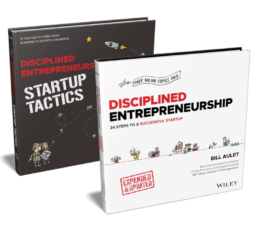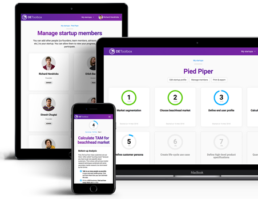 As the Disciplined Entrepreneurship 24 step methodology has become more refined and robust from all the utilization it has gotten of the past five years, it has become clear to me that more and more the gating factor to success is the quality of the information utilized in executing the framework. This is Primary Market Research (PMR). If we put garbage PMR in, we will get garbage results out.
As the Disciplined Entrepreneurship 24 step methodology has become more refined and robust from all the utilization it has gotten of the past five years, it has become clear to me that more and more the gating factor to success is the quality of the information utilized in executing the framework. This is Primary Market Research (PMR). If we put garbage PMR in, we will get garbage results out.
However, how do we get good customer and market data? That was an important element of the DE Workbook and I did some research to write the primer in that book. Still, I felt I did not do it justice. There is some good work done by Giff Constable and Frank Rimalovski with their books Talking to Humans and Testing with Humans, but even with these books, there is more needed.
As I have thought about this, given lectures and done a lot of coaching in this area, I have come back to journalists as being great purveyors of this skill. The good ones are able to be empathetic listeners, they are able to assess a situation and incredibly efficiently and effectively extract information from people. In fact, this is a fundamental of their job, which they have to perform every day.
This past week during a workshop in Norway, I had the great fortune to have a highly accomplished (6 years) journalist who was a participant. As I was talking about this subject, this fact became known and I had him speak to the class about how he gets so much information. He gave a brilliant 15-minute talk which led me to ask him if he could summarize the key actionable points in a short email.
Below are Trygve Meyer’s 15 key points. Trygve spent 6 years working at Bloomberg interviewing thousands of people up to the highest levels in Norway. I find them useful to think about but the key is to practice them so they become second nature.
Here they are with a sincere thanks to Trygve for sharing them:
- The start of any good interview is preparation. Do your homework and use the resources at your disposal to collect information. For instance, using LinkedIn, Facebook, Twitter, friends, colleagues, publications etc. This information will not only make the interview more productive, but it will also make the interviewer more comfortable from the start of the interview.
- Do spend a little time before the interview in their normal setting. Use your senses – eyes and ears. Pay attention to layout, view, objects such as art and books.
- Find a good location for doing the interview. Preferably away from their normal office space. It is best to avoid a space they “own,” but at the same time, it has to be a place where the setting that will bring the interviewed person to ease. So, familiarity is important – need to be on “their territory.” Avoid public spaces too because of distractions and noise.
- Write down your questions in advance. Have at least twice as many questions as you plan to ask. Some questions get covered during the interview without being asked, so to avoid cutting it short – have backup questions.
- Ask if it is OK that you use a recording device. Clarify that it will be “only used for reference” and will not be used in any other setting or way.
- Make sure you make a series of open-ended questions that can create further avenues for exploration. “What is your ideal solution/resolution? Why do you care about this problem? Do you have any ideas for how to solve the problem?” Then follow up by “You said xyz – what did you mean by that? Can you further elaborate?”
- Have a clear plan for the progression of questions. Start with easy and open questions that will make the interviewed person to further ease and open up. A typical question can be: tell me about your normal workday?
- Work on asking the questions. Think of varieties of the same question. How many different ways can you ask the same question? How old are you? When were you born?
- If questions are avoided – go back and revisit the topic through a rephrased version of the same question. By the third time, something is answered the depth level and context will start to be close to the “truth.”
- Ask the person being interviewed to re-enact or show you how certain things are done or how a particularly interesting point happened.
- Use “yes”, smiles and positive grunts to reinforce what is being said. A supportive and empathetic listener will get more information than one that is not supportive. Keep in mind that you will want to strike a balance between becoming a cheerleader and getting the job done of getting the information.
- Use body language to reinforce the “yes” and the grunts. Nodding of head etc. May want to “mimic” the person being interviewed if this falls natural to you. Not like every move because it should not be done in a way that makes it obvious and it looks like you are fully replicating their every move.
- Do not sit with your arms crossed. Do not lean back and seem disinterested. Sit at the front of the chair and listen keenly to what is being said.
- Don’t jump in with new question once the previous one is answered. Silence and pause often will prompt the interviewed person to fill the silence with more information. Likewise, keep recording after the “official” interview is over. There are often snippets of gold being offered right as one is rounding off. The interviewed person is then at the most relaxed and lets down their guards.
- Bring a “wing-man”. Keep in mind that it takes a lot of concentration to listen and guide a conversation in an interview setting. A second person can spend their time observing body language and be a second note taker. Always good to have someone to discuss answers and observations with after an interview.
In addition to these, Trygve shared that his mindset and often openly shared approach for any interview that. “I have no opinion on this matter.” Of course, over time, he will start to form an opinion but it is important that he start in a non-judgmental frame of mind so he is completely open to whatever the person being interviewed is saying. A good journalist (and PMR collector) does not steer the conversation to his hypotheses (bad journalist do). It is very important that is your overall tone and it is projected and acted upon for the whole interview. You are NOT selling, you are in inquiry mode and collecting data points to be analyzed.
Do you agree with the key points above? If so, which and what would you suggest? Are there other key tips that you want to share?
PMR is a skill that develops over time. Like entrepreneurship, it is learned in the apprenticeship model. You can only really learn by doing but still, it is nice to know the fundamental principles you should be executing when you “do”. So jump in and try the techniques mentioned about. You should always be doing PMR so it should not be long from now. The day a company stops doing PMR is the day that the company begins the slow but sure process of dying.
The author
Bill Aulet
A longtime successful entrepreneur, Bill is the Managing Director of the Martin Trust Center for MIT Entrepreneurship and Professor of the Practice at the MIT Sloan School of Management. He is changing the way entrepreneurship is understood, taught, and practiced around the world.

The Disciplined Entrepreneurship Toolbox
Stay ahead by using the 24 steps together with your team, mentors, and investors.
The books
This methodology with 24 steps and 15 tactics was created at MIT to help you translate your technology or idea into innovative new products. The books were designed for first-time and repeat entrepreneurs so that they can build great ventures.

How relevant was this article to you?
Click on a star to rate it!
Average rating 4.8 / 5. Vote count: 21
No votes so far! Be the first to rate this post.
We are sorry that this article was not useful for you!
Let us improve this post!
Tell us how we can improve this post?
